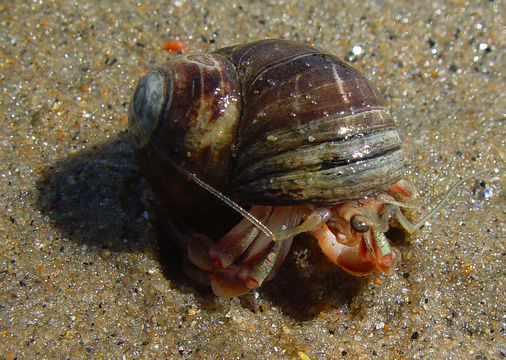Caring for Hermit Crabs – Crustaceans
http://www.enchantedlearning.com/subjects/invertebrates /crustacean/Hermitcrab.shtml
Taxonomy:
Kingdom: Animalia
Phylum: Arthropoda
Subphylum: Crustacea
Class: Malacostraca
Subclass: Eumalacostraca
Superorder: Eucarida
Order: Decapoda
Suborder: Pleocyemata
Infraorder: Anomura
Superfamily: Paguroidea
Family: Paguridae (Note: there are 6 other Families of Hermit Crabs)
Genus: Pagurus
There are 1100 species of hermit crabs worldwide, organized into seven families. The above taxonomical listing shows how complex taxonomical classification can get, with the main 7 levels of classification highlighted in red. “Sub” means below, “Super” means above, and “Infra” means within, for your information. The 7 formally recognised Families follow.
- Coenobitidae Dana, 1851 – 2 genera: terrestrial hermit crabs
- Diogenidae Ortmann, 1892 – 20 genera of “left-handed hermit crabs”
- Paguridae Latreille, 1802 – 76 genera
- Parapaguridae Smith, 1882 – 10 genera
- Parapylochelidae Fraaije et al., 2012 – 2 genera
- Pylochelidae Bate, 1888 – 9 genera of “symmetrical hermit crabs”
- Pylojacquesidae McLaughlin & Lemaitre, 2001 – 2 genera
( Source: http://en.wikipedia.org/wiki/Hermit_crab#Classification )
There are 153 species under the Family Paguridae, according to the wonderful Catalogue of Life database. See here for full information for the Family Paguridae.
Pagurus pollicaris
Common name: Grey Hermit Crab
I have already posted about how Taxonomy works – at the Blog post below – if you would like to know more about it.
https://facinatingamazinganimals.wordpress.com/2012/03/11/animal-trees/
Some tips on keeping healthy Hermit Crabs.
- A glass tank is preferred over plastic tanks, which will scratch and do not hold the humidity with the ventilated lids. A guide on how many Hermit Crabs to have in your tank can be found by clicking here. Note, it is important not to over-crowd your tank.
- Temperature no lower than 75°F. Consistent low temperatures can kill a hermit crab. If they get too hot they will die, overheating causes irreversible damage and a slow, painful death. You must buy a hygrometer (humidity gauge) and a thermometer. Hermit Crabs are tropical creatures.
- A constant humidity level of at LEAST 70% humidity. Hermit crabs breathe through (hardened) gills, and can’t breathe properly unless the air is humid enough. Lower humidity will cause suffocation.
- Hermit Crabs are taken from the wild, shipped to the wholesalers then to the retailers. This is incredibly stressful on them. Once you get them home, they go through a “De-stressing” period that can take as little as a few days and as long as two months.
- Never use gravel, wood chips, synthetic fiber, cedar, or gel for the substrate the Hermit Crabs will live on. Hermit Crab Salt is usually a Rock or Sea Salt based hermit crab-friendly salt to add to the salt-water pond within your tank along with the fresh water dish. Never use plain table salt.
- Avoid buying painted shells or shell painting kits. They are toxic to the crab.
- Do not handle your hermit crab too much or it might die because of the oils on your hands.
- Land Hermit Crabs need fresh food and water every day.
- You will need to spend at least five minutes at morning and night time refilling water and food dishes; picking through the substrate for any food that has fallen or been dragged out of the food bowl and to check for signs of any problems or illness.
- Moulting is responsible for most of the deaths of land hermit crabs in captivity. They need to have adequate moulting conditions or they will not survive. The substrate should be deep enough so that it is double the height of the largest hermit crab at least one section of the tank. You should also make allowances for a small isolation unit for each hermit crab, and have it prepared beforehand if possible.










I love the hermit crabs, but of course I live where they roam naturally so enjoy them whenever I visit the beach. They have such charisma!
Thanks for educating those who have hermit crab pets, so they can give them the best care possible. ‘
z
Thank you Z. I too love Hermit Crabs, and that is exactly why I researched & posted this! Our family had hermit crabs in a tank at home while I was a child, but didn’t look after them well. I felt so sorry for those Hermit Crabs and promised myself to do what I could to otherwise look after these fascinating creatures!
You are doing a great job; your favicon/gravatar is precious, and your comment box brings a pawprint smile. Before long you’re going to be overwhelmed with comments and likes! Z